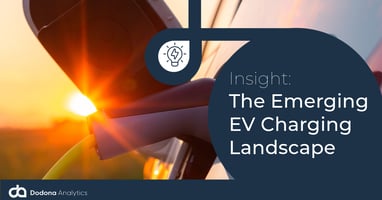The time is now. With a perfect storm of government regulation, investment, and rising electric...

Despite the reported softening of the EV market, there is a fantastic business opportunity for CPOs, the underlying economic fundamentals for investing in EV infrastructure remain strong, driven by a perfect market storm of demand, supply and regulation.
A Global Shift
The transportation sector is undergoing a significant transformation. Electric vehicles (EVs) are steadily gaining ground, driven by environmental concerns, government incentives, and technological advancements. This presents a fascinating development with a crucial drawback: the lack of widespread charging infrastructure.
UK
The UK government has set ambitious targets for EV adoption, aiming for all new cars sold to be zero-emission by 2035. This ambition is reflected in the impressive growth of EVs. As of April 2024, there are over 1.1 million fully electric cars on UK roads, with plug-in hybrids adding another 655,000 to the electrified fleet. Battery-electric car registrations are surging, reaching nearly 315,000 in 2023, and electric vehicles now account for a significant chunk (almost 17%) of all new car registrations in the UK. 1
This rapid shift towards electric mobility highlights a critical need for more charging infrastructure. The UK’s public EV charging infrastructure is expanding rapidly. In April 2024 there were over 61,000 public charging points, a 45% increase since April 2023 2. Despite this, significant investment is required to keep pace with EV adoption. The government aims to install 300,000 public EV chargers by 2030.
However, the current pace of installation falls significantly short of this goal. In fact, one estimate suggests that the UK is 12 years behind schedule in meeting this target. The rate of installation from 2023 would leave the UK with less than half the target number by 2030 3. The charge points are unevenly distributed with London having the best coverage, followed by the South East and Scotland, leaving many other regions behind. 4
Europe
Europe is at the forefront of the EV revolution. In 2023, nearly 14 million new electric cars were registered globally, and Europe accounted for roughly a quarter of those sales, translating to almost 3.5 million new EVs on European roads. This brings the total number of EVs in Europe to over 10 million, with battery electric cars (BEVs) making up a significant portion (70%) of the stock. 5
Despite significant growth in EV sales, the expansion of charging infrastructure has not kept pace. Between 2017 and 2023, the number of public chargers increased merely sixfold, while electric car sales increased over 18 times. This has resulted in a significant gap between the number of electric vehicles on the road and the number of public charging points available (around 632,000 at the end of 2023) in the EU.
The European Commission estimates that 3.5 million charging points are needed by 2030, while ACEA estimates a much higher number of 8.8 million. At the current pace of installation, Europe will fall far short of its charging point targets, with an estimate of needing 8 times more charging points per year by 2030. Additionally, there are significant regional disparities as three countries (Netherlands, France, and Germany) account for nearly two-thirds of all charging points, while many others have very few. 6
USA
The US is aiming for a dramatic shift towards EVs to meet climate goals. Government policies, ambitious industry targets, and recent legislation are all pushing for a rapid transition. Analyst projections suggest EVs could make up nearly half of US light-duty vehicles by 2030. 7 As of the fourth quarter of 2023, there are approximately 3.3 million electric cars on U.S. roads. This number has significantly increased from 2 million in 2022 and 1.3 million in 2021. 8
As the number of EVs grows, so does the need for charging infrastructure. By 2030 the expected number of EVs on American roads is 33 million and the charging network needed to support that amounts to 28 million ports. While most charging is expected to take place in a private setting, the public network of 182,000 public fast charging stations and 1 million public Level 2 chargers is crucial for those without home charging and to support ride-hailing and long-distance travel. The investment into the public charging infrastructure is expected to be $31-$55 billion. 9
The Perfect Market Storm
In any emerging market, there are three primary commercial drivers; demand, supply and regulation. When you have a perfect storm of all three, you have a megatrend, and this is where EV infrastructure finds itself today.
Demand
Wealthy, status-conscious customers, who are the typical technology early adopters, have driven the growth of the EV market so far. But a growing awareness of environmental issues, regulation, more choice, cheaper models, and the lowering cost of running and owning an electric vehicle mean the EV market is moving into the mainstream.
A widely accepted model, the Technology Adoption Lifecycle 10, describes this phenomenon. Research shows that 68% of the potential market for new technology is in this mainstream, and this is without taking into account the regulatory and legislative drivers that are artificially forcing the EV market.

.
And we are seeing evidence of this. The UK saw a 15% increase in EV adoption in 2023. 11
Aside from legislation artificially forcing this market, the key factor on the demand side is the cost to the consumer. EV adoption will be stifled if it continues to be seen as a premium-priced product, so getting to total cost of ownership (TOC) parity between EVs and ICE vehicles is critical.
This is already happening, especially in marketers, where factors such as governmental subsidies, charging infrastructure developments, and supply-side factors are bridging this affordability gap. But, in general, even without these factors, this milestone of cost parity between EVs and ICE vehicles is projected to be reached in Europe in late 2025 or early 2026.
In their 2023 report on Future Mobility 12 McKinsey shared research that states:
“With more EVs on roads in Europe, it will need a major build-out of its EV-charging infrastructure. A recent analysis suggests that in even the most conservative scenario, the EU-27 will require at least 3.4 million operational public-charging points by 2030—a significant step up from the estimated 375,000 charging stations in 2021”
All suggesting that EV ownership is on the cusp of a boom.
Supply
While there has been a much-reported slight slowdown in EV demand in 2023, according to the Financial Times13 during 2025, on current projections, output will rise to 18M vehicles; an astonishing 70 percent increase in global EV output in just two years.
This increase in output is being fueled by more manufacturers and an increasing range of models from existing manufacturers coming onto the market. A recent article from Autocar 14 listed 44 new EV vehicles due to be launched in the UK in 2024 alone.
Plus, other areas of the EV supply chain are seeing innovation that will support this growth, specifically battery manufacturers, who are making technological advancements in the materials used, efficiency, range available, cost to manufacture, and weight, all of which are part of consumer consideration.
Regulation
Keen to take action against climate change, governments worldwide have their thumb on the scale of this market, as they are providing stimulus to demand through regulation and subsidies.
More and more governments are making public pledges and setting targets aimed at reducing the environmental impact of internal combustion engine (ICE) vehicles on the environment, and the pro-EV regulation trend is expected to continue.
An example of such commitments is the UK Net Zero Strategy, which outlines policies and proposals for decarbonising all areas of the UK economy, including automotive. In this sector, the goal is to gradually phase out sales of ICE vehicles, only allowing sales of zero-emission vehicles by 2035.
Along with these pledges, governments are also providing large amounts of public funding to support the transition. The UK has launched the Local Electric Vehicle Infrastructure (LEVI) fund, with £343 million available through 2025, which is encouraging private investment in the sector. Aside from these large funds, the government is also supporting individuals and businesses in EV purchase and charger installation through multiple individual grants.
A Great Time to Invest
The growing Charge Point Operator (CPO) market is well-positioned to benefit from this ‘megatrend’. Rarely is a new technology supported by strong supply and demand with a guiding hand of government consensus on investing and legislating in favour of this emerging industry.
References
[1] https://www.zap-map.com/ev-stats/ev-market
[2] https://www.zap-map.com/ev-stats/how-many-charging-points
[3] https://electricalreview.co.uk/2023/09/12/uk-risks-missing-ev-charger-installation-target/
[4] https://www.zap-map.com/ev-stats/how-many-charging-points
[5] https://www.iea.org/reports/global-ev-outlook-2024/trends-in-electric-cars
[6] https://www.acea.auto/publication/automotive-insights-charging-ahead-accelerating-the-rollout-of-eu-electric-vehicle-charging-infrastructure/
[7] https://www.nrel.gov/docs/fy23osti/85654.pdf
[8] https://www.iea.org/reports/global-ev-outlook-2024/trends-in-electric-cars
[9] https://www.nrel.gov/docs/fy23osti/85654.pdf
[10] https://en.wikipedia.org/wiki/Technology_adoption_life_cycle
[11] https://www.iea.org/reports/global-ev-outlook-2024/trends-in-electric-cars
[12] https://www.mckinsey.com/industries/automotive-and-assembly/our-insights/future-mobility-2022-hype-transitions-into-reality
[13] https://www.ft.com/content/49886479-7312-43f5-a190-94d7586738f7
[14] https://www.autocar.co.uk/car-news/new-cars/new-electric-cars
Chris is our Co-Founder and Head of Sales. He is an evangelist for eMobility and is passionate about helping the sector make better, evidence-based decisions with data science and AI.
You can follow Chris Chamberlain on LinkedIn



